You're using an outdated browser. Please upgrade to a modern browser for the best experience.
Please note this is a comparison between Version 2 by Wendy Huang and Version 1 by Abas Ahmad.
A lattice structure is made by a unit cell that is repeated in the space, making a larger functional structure; thus, it is a peculiar kind of cellular structure. The basic idea of cellular structures evolved from natural organic structures such as bamboo, bone, cork, etc. According to the literature, in many applications, lattice structures have been found to be superior to their other cellular counterparts, such as foam and honeycomb structures.
- lattice structures
- cellular structures
- topology
- cell’s element geometry
- cell’s size
- replication pattern
- mechanical behavior
- TPMS
1. Introduction
For the very first time, the concept of cellular structures was introduced by Gibson and Ashby [1,2][1][2]. Initially, they classified cellular structures into foam (open cell and closed cell) and honeycomb. Foam’s cell shape and pattern are usually defined by random distributions, while the honeycomb structure has a regular 2D hexagonal unit cell and the cell walls are uniformly oriented in the space. In open-cell foam, the cells are not totally enclosed by their walls, while in closed-cell foam, the cells are entirely enclosed by their walls. Despite these differences, the component is always defined from a micro/mesoscale cell, replicated to fill the overall macroscale volume. However, the cellular structures were later classified [3,4][3][4] into three main categories: foam, honeycomb, and lattice.
According to the literature, in many applications, lattice structures have been found to be superior to their other cellular counterparts, such as foam and honeycomb structures. A more in detail strength-to-weight ratio and mechanical performance, such as energy absorption or compliance, is generally better due to the tailored shape of the cell and the replication pattern [6,7][5][6]. Moreover, they can support functional designs, such as heat exchangers or fluid conveyors, as demonstrated in [8][7]. More recently, taking inspiration from natural organic structures such as bones and plant stems, the concept of graded densities increased the spread of lattice structures, for example, being used to optimize load distributions [9,10][8][9]. It also furthers the evolution towards multigrade lattice structures, coupled with different materials. From this, the concept of multigrade and multifunction lattices arises. These are the solutions in which not only the type of unit cells but also the cell’s density and materials are distributed to gain a specific performance or function. Multigrade lattice structures have numerous applications, i.e., to enhance stiffness [11][10], to increase energy absorption capability [12[11][12][13][14][15][16],13,14,15,16,17], to improve thermal exchange efficiency [18,19][17][18], to tailor specific behaviors such as a negative Poisson’s ratio [20,21[19][20][21],22], etc.
-
The unit cell’s characteristics, which include topology, cell’s element geometry, and cell’s size.
-
The characteristics of the cell’s replication pattern.
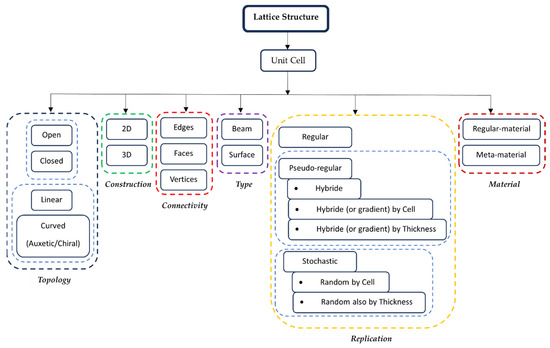
Figure 1.
Classification of lattice structure.
2. Unit Cell Characteristics
A topology-based classification defines whether the cells are closed or open and how many cells’ faces are open, while a cell’s element geometry, according to [2], distinguishes between cells made of struts and cells made of plates or shells, introducing a structural behavior classification of the cells. A cell’s element geometry includes a geometrical definition of the structural elements (sections, number of edges, …) [6,7[5][6][22][25],23,28], and the size, including all the dimensional elements that define a cell (e.g., section size and axial length for struts, length, width, and thickness for plate/shell). The cell’s element geometry, indeed, may also constrain the topology of the cell (e.g., strut cells are always open, shells and plates may be open with different geometrical shapes). Concerning the cell’s size, the distinction between homogeneous and heterogeneous defines whether the structural elements of the cell are constant or not. Figure 2 and Figure 3 show an overview of strut-based and surface-based lattice cells, respectively.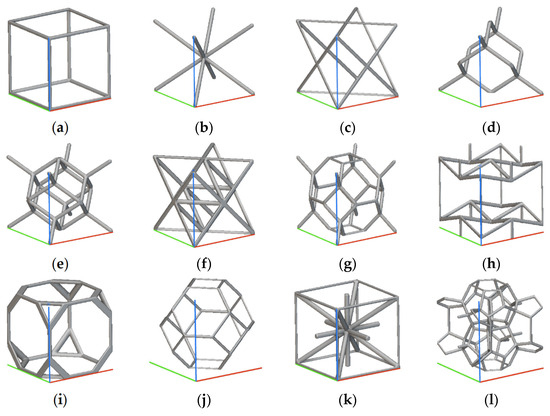
Figure 2. Beam Lattice (generated with nTop and the colored lines show the 3D reference system useful for comparison): (a) Simple Cubic Cell; (b) Body Centered Cubic Cell; (c) Face Centered Cubic Cell; (d) Diamond Cell; (e) Fluorite Cell; (f) Octet Cell; (g) Truncated Octahedron Cell; (h) Re-entrant Cell; (i) Truncated Cube Cell; (j) Kelvin Cell; (k) Iso Truss Cell; (l) Weaire–Phelan Cell.
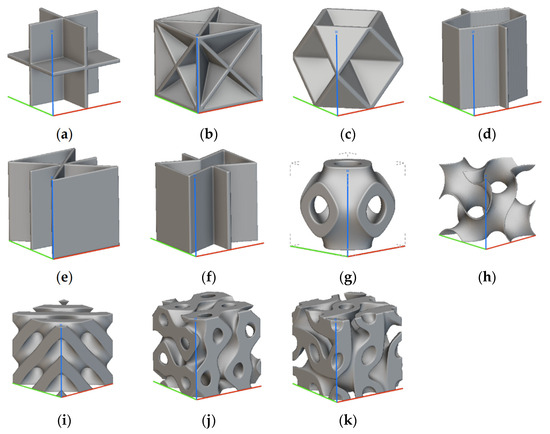
Figure 3. Surface-based lattice (generated with nTop and the colored lines show the 3D reference system useful for comparison): (a) Simple Cubic Foam Cell; (b) Body Centered Cubic Foam Cell; (c) Face Centered Cubic Foam Cell; (d) Hexagonal Honeycomb Cell; (e) Triangular Honeycomb Cell; (f) Re-entrant Honeycomb Cell; (g) Schwartz Cell; (h) Gyroid Cell; (i) Diamond Cell; (j) Split-P Cell; (k) Lidinoid Cell.
TPMS Formulation
From a mathematical point of view, a TPMS is an infinite surface, periodic along three mutually orthogonal directions, which satisfies the following conditions:3. Characteristics of the Cell Replication Pattern
Characteristics of the replication pattern are concerned with the cell’s connection, orientation, and density in the space, as discussed in [7,41,42][6][38][39]. It also pertains to the cell size in the sense that the cell’s length may also change along the replication pattern randomly or according to a gradient as a request of the design intent (e.g., functionally graded lattice structures) [43,44,45,46][40][41][42][43]. Replication patterns can be:-
Regular.
-
Pseudo-regular.
- ○
-
Hybrid,
- ○
-
Warped (or gradient) by cell size,Warped (or gradient) by thickness,
- ○
-
Conformal.
-
Stochastic.
- ○
-
Random by cell size,
- ○
-
Random also by thickness.

Figure 4.
Examples of regular replication patterns (generated with nTop): (
a
) Kelvin Cell; (
b
) Re-entrant Cell; (
c
) Re-entrant Honeycomb Cell; (
d
) Split-p Cell.
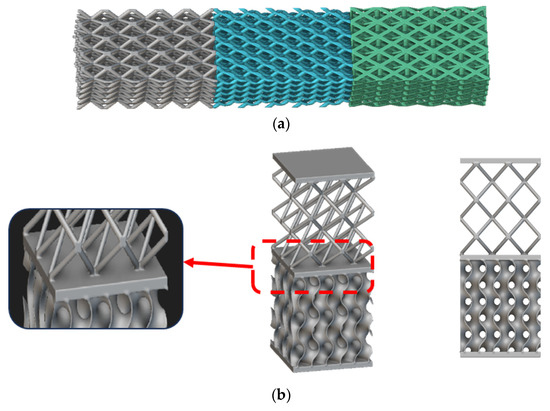
Figure 5. Examples of hybrid replication patterns achieved by changing the unit cells (generated with nTop): (a) BCC Lattice + Diamond Lattice + FCC Lattice; (b) BCC lattice + Gyroid TMPS.
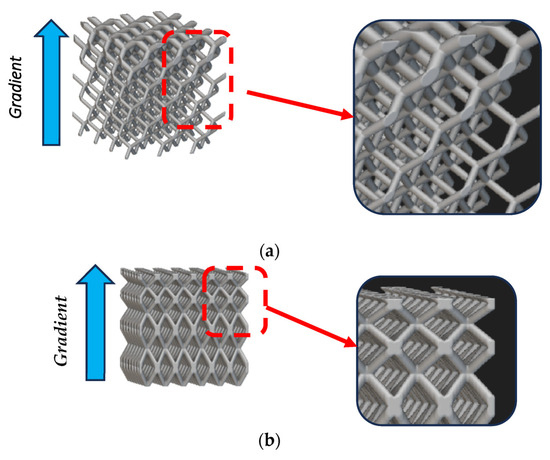
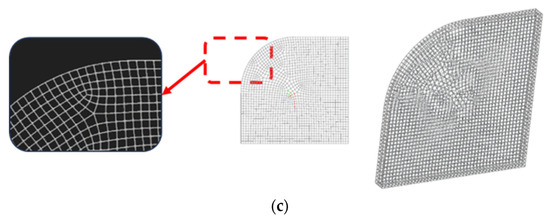
Figure 6. Examples of pseudo-regular pattern replications (generated with nTop): (a) BCC cells with gradient by thickness; (b) BCC cells with gradient by cell size; (c) Simple cubic cells conformal.

Figure 7.
Examples of stochastic replication patterns (generated with nTop): (
a
) cell’s size variation; (
b
) thickness variation by gradient.
4. Mechanical Behavior
The mechanical behavior of cellular materials is affected by the micro/mesoscale characteristics (unit cell and replication pattern), in addition to the macroscale topology and shape of the overall component [49,50][46][47]. This means that the local behaviors determine the global mechanical response and its related performance. Based on their local mechanical response, the lattice structure is generally classified into [51][48]:-
Bending dominated.
-
Stretch dominated.
where s is the number of struts, n is the number of joints in the unit cell, and 6 is the d.o.f. in cases of three-dimensional structures. When M equals zero or is greater than zero, it means that the isostatic or over-constrained solutions undertake a stretch-dominated category. The condition of M as less than zero means that the structure is a mechanism assumed to weld the joints (as it will be in a real lattice cell) and it undertakes a bending-dominated category. According to this reasoning, the bending-dominated cells are BCC and Kelvin structures, while honeycomb (if axially loaded) and Octet cells are stretch dominated (concerning the application of M to the honeycomb, it is worthwhile to remember that shell-based cells are derived from the truss-based cells, assuming the cells are closed by their walls). In [54][51], the classification between stretch- and bending-dominated structures is enriched by proposing a third class, named “programmable active”, able to actively merge the two categories. Active structures are functionally graded materials, such as auxetic cells, which have the ability to switch their behavior from stretched dominated to bending dominated. This is extremely suitable for crashworthiness designs when the defined impact loads may activate the plastic bending. According to the Gibson and Ashby power criterion [51][48], the elastic modulus of the unit cell can be calculated with the help of the following equations: For a bending-dominated lattice,
References
- Gibson, L.J. Modelling the mechanical behavior of cellular materials. Mater. Sci. Eng. A 1989, 110, 1–36.
- Gibson, L.J.; Ashby, M.F. Cellular Solids: Structure and Properties, 2nd ed.; Cambridge University Press: Cambridge, UK, 1997; pp. 16–21.
- Bhate, D. Four Questions in Cellular Material Design. Materials 2019, 12, 1060.
- Tao, W.; Leu, M.C. Design of lattice structure for additive manufacturing. In Proceedings of the 2016 International Symposium on Flexible Automation Cleveland (ISFA 2016), Cleveland, OH, USA, 1–3 August 2016; pp. 326–332.
- Pan, C.; Han, Y.; Lu, J. Design and optimization of lattice structures: A review. Appl. Sci. 2020, 10, 6374.
- Suethao, S.; Shah, D.U.; Smitthipong, W. Recent progress in processing functionally graded polymer foams. Materials 2020, 13, 4060.
- Bici, M.; Brischetto, S.; Campana, F.; Ferro, C.G.; Seclì, C.; Varetti, S.; Mazza, A. Development of a multifunctional panel for aerospace use through SLM additive manufacturing. Procedia CIRP 2018, 67, 215–220.
- Ghouse, S.; Reznikov, N.; Boughton, O.R.; Babu, S.; Ng, K.G.; Blunn, G.; Jeffers, J.R. The design and in vivo testing of a locally stiffness-matched porous scaffold. Appl. Mater. Today 2019, 15, 377–388.
- de Wild, M.; Schumacher, R.; Mayer, K.; Schkommodau, E.; Thoma, D.; Bredell, M.; Weber, F.E. Bone regeneration by the osteoconductivity of porous titanium implants manufactured by selective laser melting: A histological and micro computed tomography study in the rabbit. Tissue Eng. Part A 2013, 19, 2645–2654.
- Saxena, K.K.; Das, R.; Calius, E.P. 3D printable multimaterial cellular auxetics with tunable stiffness. arXiv 2017, arXiv:1707.04486.
- Zhang, J.; Huang, H.; Liu, G.; Zong, H.; Zhang, C. Stiffness and energy absorption of additive manufactured hybrid lattice structures. Virtual Phys. Prototyp. 2021, 16, 428–443.
- Yin, H.; Zhang, W.; Zhu, L.; Meng, F.; Liu, J.; Wen, G. Review on lattice structures for energy absorption properties. Compos. Struct. 2022, 304, 116397.
- Shan, S.; Kang, S.H.; Raney, J.R.; Wang, P.; Fang, L.; Candido, F.; Bertoldi, K. Multistable architected materials for trapping elastic strain energy. Adv. Mater. 2015, 27, 4296–4301.
- Brennan-Craddock, J.; Brackett, D.; Wildman, R.; Hague, R. The design of impact absorbing structures for additive manufacture. J. Phys. Conf. Ser. 2012, 382, 012042.
- Ozdemir, Z.; Tyas, A.; Goodall, R.; Askes, H. Energy absorption in lattice structures in dynamics: Nonlinear FE simulations. Int. J. Impact Eng. 2017, 102, 1–15.
- Habib, F.N.; Iovenitti, P.; Masood, S.H.; Nikzad, M. Fabrication of polymeric lattice structures for optimum energy absorption using Multi Jet Fusion technology. Mater. Des. 2018, 155, 86–98.
- Maloney, K.J.; Fink, K.D.; Schaedler, T.A.; Kolodziejska, J.A.; Jacobsen, A.J.; Roper, C.S. Multifunctional heat exchangers derived from three-dimensional micro-lattice structures. Int. J. Heat Mass Transf. 2012, 55, 2486–2493.
- Son, K.N.; Weibel, J.A.; Kumaresan, V.; Garimella, S.V. Design of multifunctional lattice-frame materials for compact heat exchangers. Int. J. Heat Mass Transf. 2017, 115, 619–629.
- Chen, Y.; Li, T.; Scarpa, F.; Wang, L. Lattice metamaterials with mechanically tunable Poisson’s ratio for vibration control. Phys. Rev. Appl. 2017, 7, 024012.
- Chen, D.; Zheng, X. Multi-material additive manufacturing of metamaterials with giant, tailorable negative Poisson’s ratios. Sci. Rep. 2018, 8, 9139.
- Yuan, S.; Shen, F.; Bai, J.; Chua, C.K.; Wei, J.; Zhou, K. 3D soft auxetic lattice structures fabricated by selective laser sintering: TPU powder evaluation and process optimization. Mater. Des. 2017, 120, 317–327.
- Savio, G.; Rosso, S.; Meneghello, R.; Concheri, G. Geometric modeling of cellular materials for additive manufacturing in biomedical field: A review. Appl. Bionics Biomech. 2018, 2018, 1654782.
- Ramirez-Chavez, I.E.; Anderson, D.; Sharma, R.; Lee, C.; Bhate, D. A classification of aperiodic architected cellular materials. Designs 2022, 6, 63.
- Álvarez-Trejo, A.; Cuan-Urquizo, E.; Bhate, D.; Roman-Flores, A. Mechanical metamaterials with topologies based on curved elements: An overview of design, additive manufacturing and mechanical properties. Mater. Des. 2023, 233, 112190.
- Zhang, Q.; Yang, X.; Li, P.; Huang, G.; Feng, S.; Shen, C.; Lu, T.J. Bioinspired engineering of honeycomb structure-Using nature to inspire human innovation. Prog. Mater. Sci. 2015, 74, 332–400.
- Yan, C.; Hao, L.; Hussein, A.; Bubb, S.L.; Young, P.; Raymont, D. Evaluation of light-weight AlSi10Mg periodic cellular lattice structures fabricated via direct metal laser sintering. J. Mater. Process. Technol. 2014, 214, 856–864.
- Hunt, C.J.; Morabito, F.; Grace, C.; Zhao, Y.; Woods, B.K. A review of composite lattice structures. Compos. Struct. 2022, 284, 115120.
- Luxner, M.H.; Stampfl, J.; Pettermann, H.E. Finite element modeling concepts and linear analyses of 3D regular open cell structures. J. Mater. Sci. 2005, 40, 5859–5866.
- Deshpande, V.S.; Fleck, N.A.; Ashby, M.F. Effective properties of the octet-truss lattice material. J. Mech. Phys. Solids 2001, 49, 1747–1769.
- Lakes, R. Foam structures with a negative Poisson’s ratio. Science 1987, 235, 1038–1040.
- Wang, F. Systematic design of 3D auxetic lattice materials with programmable Poisson’s ratio for finite strains. J. Mech. Phys. Solids 2018, 114, 303–318.
- Kumar, S.; Vyavahare, S.; Teraiya, S.; Kootikuppala, J.; Bogala, H. A state of the art review of additively manufactured auxetic structures. In Recent Advances in Manufacturing Processes and Systems: Select Proceedings of RAM 2021; Springer: Singapore, 2022; pp. 69–84.
- Xue, Y.; Gao, P.; Zhou, L.; Han, F. An enhanced three-dimensional auxetic lattice structure with improved property. Materials 2020, 13, 1008.
- Berger, J.B.; Wadley, H.N.G.; McMeeking, R.M. Mechanical metamaterials at the theoretical limit of isotropic elastic stiffness. Nature 2017, 543, 533–537.
- Xue, R.; Cui, X.; Zhang, P.; Liu, K.; Li, Y.; Wu, W.; Liao, H. Mechanical design and energy absorption performances of novel dual scale hybrid plate-lattice mechanical metamaterials. Extrem. Mech. Lett. 2020, 40, 100918.
- Al-Ketan, O.; Abu Al-Rub, R.K. Multifunctional mechanical metamaterials based on triply periodic minimal surface lattices. Adv. Eng. Mater. 2019, 21, 1900524.
- AlMahri, S.; Santiago, R.; Lee, D.W.; Ramos, H.; Alabdouli, H.; Alteneiji, M.; Alves, M. Evaluation of the dynamic response of triply periodic minimal surfaces subjected to high strain-rate compression. Addit. Manuf. 2021, 46, 102220.
- Song, J.; Tang, Q.; Feng, Q.; Ma, S.; Guo, F.; Han, Q. Investigation on the modelling approach for variable-density lattice structures fabricated using selective laser melting. Mater. Des. 2021, 212, 110236.
- Al Khalil, M.; Lebaal, N.; Demoly, F.; Roth, S. A design and optimization framework of variable-density lattice structures for additive manufacturing. Mech. Adv. Mater. Struct. 2022, 29, 4711–4725.
- Sienkiewicz, J.; Płatek, P.; Jiang, F.; Sun, X.; Rusinek, A. Investigations on the mechanical response of gradient lattice structures manufactured via SLM. Metals 2020, 10, 213.
- Seharing, A.; Azman, A.H.; Abdullah, S. A review on integration of lightweight gradient lattice structures in additive manufacturing parts. Adv. Mech. Eng. 2020, 12, 1687814020916951.
- Li, D.; Liao, W.; Dai, N.; Xie, Y.M. Anisotropic design and optimization of conformal gradient lattice structures. Comput.-Aided Des. 2020, 119, 102787.
- Seharing, A.; Azman, A.H.; Abdullah, S. Finite element analysis of gradient lattice structure patterns for bone implant design. Int. J. Struct. Integr. 2020, 11, 535–545.
- Fabbro, P.D.; Rosso, S.; Ceruti, A.; Meneghello, R.; Concheri, G.; Savio, G. Conformal Lattice Structures: Modeling and Optimization. In Design Tools and Methods in Industrial Engineering II, Proceedings of the International Conference on Design, Simulation, Manufacturing: The Innovation Exchange, ADM 2021, Rome, Italy, 9–10 September 2021; Springer International Publishing: Cham, Switzerland, 2021; pp. 474–485.
- Nguyen, J.; Park, S.I.; Rosen, D.W.; Folgar, L.; Williams, J. Conformal lattice structure design and fabrication. In Proceedings of the 2012 International Solid Freeform Fabrication Symposium, Austin, TX, USA, 6–8 August 2012; University of Texas at Austin: Austin, TX, USA, 2012.
- D’Angelo, C.; Ortona, A.; Colombo, P. Influence of the loading direction on the mechanical behavior of ceramic foams and lattices under compression. Acta Mater. 2013, 61, 5525–5534.
- Singamaneni, S.; Bertoldi, K.; Chang, S.; Jang, J.H.; Young, S.L.; Thomas, E.L.; Tsukruk, V.V. Bifurcated mechanical behavior of deformed periodic porous solids. Adv. Funct. Mater. 2009, 19, 1426–1436.
- Ashby, M.F.; Gibson, L.J. Cellular Solids: Structure and Properties; Press Syndicate of the University of Cambridge: Cambridge, UK, 1997; pp. 175–231.
- Tumino, D.; Alaimo, A.; Orlando, C.; Valvano, S. A Preliminary Study on the Effect of Strut Waviness on the Mechanical Properties of BCC Lattice Unit Cells. In Design Tools and Methods in Industrial Engineering II, Proceedings of the International Conference on Design, Simulation, Manufacturing: The Innovation Exchange, ADM 2021, Rome, Italy, 9–10 September 2021; Springer: Cham, Switzerland, 2021; pp. 431–441.
- Graziosi, S.; Ballo, F.M.; Libonati, F.; Senna, S. 3D printing of bending-dominated soft lattices: Numerical and experimental assessment. Rapid Prototyp. J. 2022, 28, 51–64.
- Wagner, M.A.; Lumpe, T.S.; Chen, T.; Shea, K. Programmable, active lattice structures: Unifying stretch-dominated and bending-dominated topologies. Extrem. Mech. Lett. 2019, 29, 100461.
- Benedetti, M.; Du Plessis, A.; Ritchie, R.O.; Dallago, M.; Razavi, S.M.J.; Berto, F. Architected cellular materials: A review on their mechanical properties towards fatigue-tolerant design and fabrication. Mater. Sci. Eng. R Rep. 2021, 144, 100606.
- Wei, K.; Yang, Q.; Ling, B.; Xie, H.; Qu, Z.; Fang, D. Mechanical responses of titanium 3D kagome lattice structure manufactured by selective laser melting. Extrem. Mech. Lett. 2018, 23, 41–48.
- Elipe, J.C.Á.; Lantada, A.D. Comparative study of auxetic geometries by means of computer-aided design and engineering. Smart Mater. Struct. 2012, 21, 105004.
More
